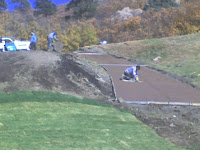About a week ago I attended a local Turfgrass Conference and Tradeshow here in town and I have to say that there was a definite lack of substance. By that I mean obviously in these tough economic times many venders had a smaller presence which is understandable, but the lectures that were given were thin on information.
At first glance of the brochure that contained the list of speakers and topics that were going to be presented several interested me. Unfortunately my interest was quickly lost by speakers who offered little new information on the topics they were presenting. Even worse was the fact that some of the techniques that were being discussed were factually incorrect and did not even apply to the topic at hand. Unfortunately many of these speakers spend most of their time in academia, where there is little connection to real world situations.









 Core drilling a hole for the mainline pipe
Core drilling a hole for the mainline pipe Pump components
Pump components







































